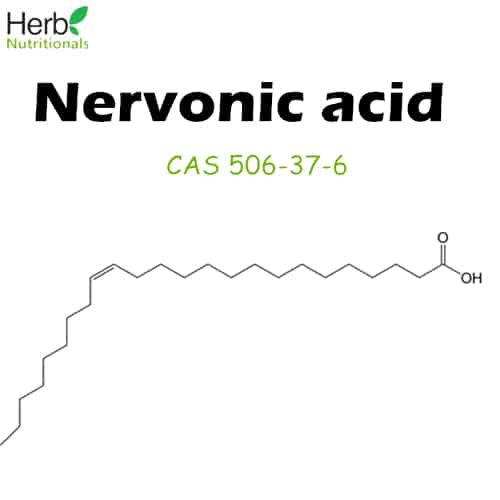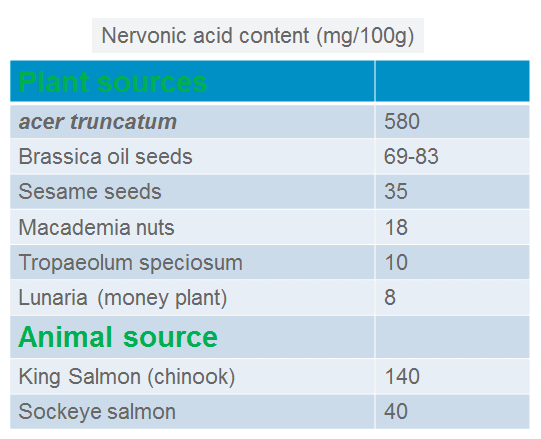Nervonic acid
| Product name | Acer truncatum extract nervonic acid |
| Botanical source | purpleblow maple seed |
| Latin Name | Acer truncatum Bunge |
| Synonyms | selacholeic acid, cis-15-tetracosenoic acid, (15Z)-tetracosenoic acid, (Z)-15-tetracosenoic acid, cis-delta(15)-tetracosenoic acid, 24:1n-9, Omega 9, shantung maple, purpleblow maple |
| CAS Number | 506-37-6 |
| Molecular formula | C24H46O2 |
| Molecular Weight | 366.62 |
| Specifications | 90%, 95%,97%,98% |
| Appearance/color | White to Off White crystalline flakes/powder |
| Solubility | insoluble in water (slightly soluble ) |
| melting point | 42.5-43 °C |
| Benefits | Brain health, nootropics |
| Applications | food, cosmetics, supplements, medicines |
| Dosage | 200mg to 300 mg |
| Package | 1kg/bag, 25kg/drum |
What is nervonic acid?
Nervonic acid may be new to the market, and the majority may have never heard of it before. As a monounsaturated omega-9 fatty acid, nervonic acid is beneficial to memory-related brain health, anti-aging, blood lipid regulation, anti-fatigue, etc. And now many companies also sell it as a nootropic. Omega 9 includes several types of fats. However, there are four of them which are the most important: oleic acid, mead acid, erucic acid and nervonic acid.
With CAS number 506-37-6, nervonic acid is known as selacholeic acid, which is initially isolated from the cerebroside of sharks. Nervonic acid is usually found in the sphingolipids of white matter in human brain, with the highest content in the neural tissues and brain tissues, being an important part of the cell membranes.
Natural sources of nervonic acid
Nervonic acid is mainly extracted from shark brains or shark oils in the Europe and The America. The process and technique are tough, and the final cost is more than 100, 000 US dollars per kilo, too high to commercialize nervonic acid ingredient to the supplement stores. In addition, sharks are protected by the United Nations and many countries in the world, so the animal sources are not acceptable.
Biosynthesis from chemicals or other intermediates are not available from present. The yield is low or too many by-products which is not good to the human health.
The only sources of nervonic acid rely on plants and herbals.
It was found that the dried seed of acer truncatum (purpleblow maple) contained 46.6% oil, in which linoleic acid, oleic acid, and erucic acid were the major fatty acids, with their content 46.6%, 33.9%, 23.8% respectively. More importantly, the oil contained noticeable amounts of nervonic acid 5.8% and vitamin E 125.23 mg/100 g, which is the most biologically active isomer. Therefore, the seed oil may be considered as a potential new source for natural nervonic acid and vitamin E.
Malania oleifera plant is said to have very high content of nervonic acid, up to 40.92% to 50% of the lipid (usually triglyceride). Malania oleifera is native to southern China in the western provinces like Guangxi and southeastern Yunnan provinces. However, Malania oleifera plant is a threatened species in the world, and it is on the list of key wild plants for state protection. So there is no room for extraction for wild malania oleifera. Cultured malania oleifera plants are experimented in some parts of the plantations. Maybe in the years to come, we may have better options for nervonic acid. However, for the time being, acer truncatum is the best natural source for the highest nervonic acid.
The table below is a list of natural food resources of nervonic acid from both plants and animals, with nervonic acid content in mg/100g
Chemical constituents of Acer truncatum plant
As we have mentioned above that acer truncatum plant is the best natural source for nervonic acid, let’s look into the chemical composition in this plant. Because the shape of the acer truncatum plant resembles shoe-shaped gold ingot, a popular currency used in ancient China, it is named Yuanbao Feng in Chinese Pinyin.
There are many kinds of chemical constituents in the extraction of Acer truncatum Bunge, such as flavones, organic acids, protein, amylase, tannin and so on. The seeds of acer truncatum have very high rate of oils up to 45% to 48%, while the fatty acids of acer truncatum seed oil contain 5% to 6% nervonic acid. Because only a few plant species contain nervonic acid, and the nervonic acid on the international market primarily comes from deep sea fish, acer truncatum (purpleblow maple) is considered to be a new sustainable resource for obtaining nervonic acid, better than malania oleifera. Acer truncatum extract is the best source, environment-friendly,more sustainable, and cost saving.
Mechanism of action of nervonic acid
How does nervonic acid work? At present, the exact mode of action of nervonic acid is not available. Not many studies or research on its mechanism yet. However, nervonic acid is said to play an important role in the biosynthesis of nerve cell myelin. Nervonic acid is the first and only magic substance recognized by scientists from various countries all over the world that is able to repair and dredge damaged brain pathways-nerve fiber, and promotes the regeneration of nerve cells to grow.
Nervonic acid benefits
There is increasing evidence that dietary supplementation with nervonic acid is healthy for babies and infants during the early stage of brain development. Nervonic acid has been reported to reduce the shaking associated with Parkinson’s disease and the numbness caused by multiple sclerosis. It also has potential for treating schizophrenia and reducing early Alzheimer’s symptoms.
Nervonic acid and brain health
Nervonic acid is the core constituents of brain nerve fibers and nerve cells. Deficiency of nervonic acid will case a series of brain-related diseases, such as sequela of apoplexy, senile dementia, cerebral palsy, brain atrophy, memory loss, insomnia, forgetfulness, etc. Moreover, nervonic acid is not endogenous, and can be only obtained by supplementation from natural foods or dietary supplements.
Nervonic acid and Alzheimer’s
Prevention of dementia (Alzheimer’s disease) and cerebral atrophy is a worldwide topic. Nervonic acid now offers its contribution to the solution. Nerve acid could completely cross the blood brain barrier and directly into the damaged parts of the nerve fibers and nerve cells, so that the damaged part of the nerve fibers to protect sheath regeneration, effectively dissolve the channel of necrosis tissue, while repairing twisted, broken nerve fiber, improving the nutritional supply of nerve fibers, helping the elderly to improve memory, prevent and treat senile dementia.
Nervonic acid and healthy cholesterol
Nervonic acid has been confirmed both at home and abroad to effectively regulate blood lipids, reduce harmful cholesterol, elevate good cholesterol. nervonic acid is proved to reduce the incidence of cardiovascular disease, heart disease.
Here below is a list of possible benefits that nervonic acid may bring:
-anti-aging
-anti-fatigue
-enhance immune support
In addition, the latest studies show that nervonic acid has positive effects for the treatment of epilepsy (seizure)
Nervonic acid side effects
In 2011, in the Chinese government NO.9 announcement, Both Food Safety Law of the People’s Republic of China and Regulations of Novel foods approve Acer truncatum Bunge Seed Oil and Peony Seed Oil as the new resources food ingredients. In other words, the safety status of Acer truncatum has been recognized by the authority. As the active ingredient in acer truncatum, nervonic acid is believed to be safe and no any serious adverse effects have been reported yet. However, do not overdose in a short time.
Nervonic acid dosage
Since Nervonic acid is almost insoluble in water, it often sold in the form of capsules. Generally speaking, two capsules orally every time, and two doses or two times a day, one in the morning, and the other in the evening. The recommended dosage ranges from 200mg to 300mg of pure nervonic acid.
Where to buy Nervonic acid powder?
Although the finished products of nervonic acid on the dietary supplements market are in capsules, Herb Nutritionals Co., Ltd supplies bulk raw nervonic aicd in powder form. The nervonic acid specification is 95% min (usually in 97% to 98%).Nervonic acid powder is packed in 1kg/bag or 25kg/drum. Nervonic acid manufacturers are not so many, and we are one of them. If you are want to buy nervonic aicd in large quantities, and inquiry pricing, COA, MSDS for it, please feel free to contact us for more details.


